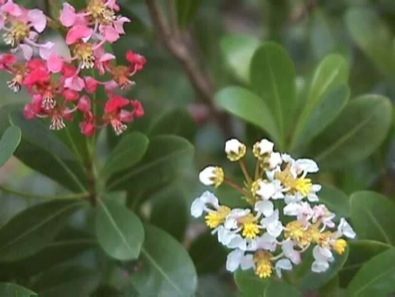Byrsonima lucida: Food and Medicine
The Locusberry rises to the occasion. When the soil is poor it is a foot-high tree. When the soil is good, it can be ten feet high. And much father south, it’s a grown up tree.
The variability of the Locusberry, Byrsonima lucida (bur-SO-nim-uh LOO-sid-uh) doesn’t stop there. When it first flowers, the blossoms are are white. Then they turn to pink and then to crimson. This is an interesting strategy: The different colors attract different butterflies to assure pollination. Also the oil glans on the underside of the petals change color from green to yellow. Bees visit the blossoms, but not to pollinate per se. They take oil from the glands to make their nests. The fruit turns from green to red-brown, or brown-red, and persists on the tree. Some think they taste like cranberries, others think they taste soapy.
There are over 135 different Byrsonima from southern Mexico to southeastern Florida, the Caribbean down to Brazil. B. crassifolia (krass-ih-FOH-lee-uh) is considered the best. The fleshy fruits are called nance and are an underutilized crop in Latin America. In Brazil they are called muruci. The fruits are also important to wildlife including the Golden Conure, moth-butterflies, the Tehuantepec Jackrabbit, an endangered species, and the Florida Box Turtle which thinks the seeds are just great and does its best to spread them around. Byrsonima is from two Greek words, Byrsa meaning hide, and nema, meaning thread. It is a reference to the bark of some of the species. Lucida means bright. clear, lustrous, crassifolia, thick leaves. The bark is often used as a dye which appears to also be antibacterial. .
Green Deane’s “Itemized” Plant Profile
IDENTIFICATION: Shrub or a small tree to 25 feet, smooth light brown bark, leaves opposite, spatulate to obovate, one to two inches long, thin, glossy above, dull below, flowers white or pink changing to yellow or rose, five petals, half inch wide, terminal clusters. Fruit oblong or cylindrical, close to an inch long, dark purple or black.
TIME OF YEAR: Nearly all year
ENVIRONMENT: Rocky pine lands and hammocks
METHOD OF PREPARATION: Ripe fruit edible raw. They can be made into juices, wine and even ice cream, but only if you find a good tree and you like the taste.
HERB BLURB:
They have been used medicinally. The bark makes a cough medicine and has been used to treat tuberculosis and other bronchial issues. The berries are antidysenteric and astringent. With some of species the bark and berries are mildly laxative. Some are diuretic and emetic. They have also been used against syphilis.


